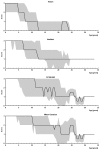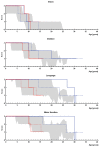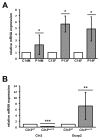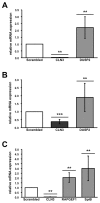Analysis of potential biomarkers and modifier genes affecting the clinical course of CLN3 disease
- PMID: 21863212
- PMCID: PMC3321816
- DOI: 10.2119/molmed.2010.00241
Analysis of potential biomarkers and modifier genes affecting the clinical course of CLN3 disease
Abstract
Mutations in the CLN3 gene lead to juvenile neuronal ceroid lipofuscinosis, a pediatric neurodegenerative disorder characterized by visual loss, epilepsy and psychomotor deterioration. Although most CLN3 patients carry the same 1-kb deletion in the CLN3 gene, their disease phenotype can be variable. The aims of this study were to (i) study the clinical phenotype in CLN3 patients with identical genotype, (ii) identify genes that are dysregulated in CLN3 disease regardless of the clinical course that could be useful as biomarkers, and (iii) find modifier genes that affect the progression rate of the disease. A total of 25 CLN3 patients homozygous for the 1-kb deletion were classified into groups with rapid, average or slow disease progression using an established clinical scoring system. Genome-wide expression profiling was performed in eight CLN3 patients with different disease progression and matched controls. The study showed high phenotype variability in CLN3 patients. Five genes were dysregulated in all CLN3 patients and present candidate biomarkers of the disease. Of those, dual specificity phosphatase 2 (DUSP2) was also validated in acutely CLN3-depleted cell models and in CbCln3(Δex7/8) cerebellar precursor cells. A total of 13 genes were upregulated in patients with rapid disease progression and downregulated in patients with slow disease progression; one gene showed dysregulation in the opposite way. Among these potential modifier genes, guanine nucleotide exchange factor 1 for small GTPases of the Ras family (RAPGEF1) and transcription factor Spi-B (SPIB) were validated in an acutely CLN3-depleted cell model. These findings indicate that differential perturbations of distinct signaling pathways might alter disease progression and provide insight into the molecular alterations underlying neuronal dysfunction in CLN3 disease and neurodegeneration in general.
Figures




References
-
- Jalanko A, Braulke T. Neuronal ceroid lipofuscinoses. Biochim Biophys Acta. 2009;1793:697–709. - PubMed
-
- Haltia M. The neuronal ceroid-lipofuscinoses. J Neuropathol Exp Neurol. 2003;62:1–13. - PubMed
-
- Williams RE, et al. Diagnosis of the neuronal ceroid lipofuscinoses: an update. Biochim Biophys Acta. 2006;1762:865–72. - PubMed
-
- International Batten Disease Consortium. Isolation of a novel gene underlying Batten disease, CLN3. Cell. 1995;82:949–57. - PubMed
Publication types
MeSH terms
Substances
Grants and funding
LinkOut - more resources
Full Text Sources
Molecular Biology Databases

